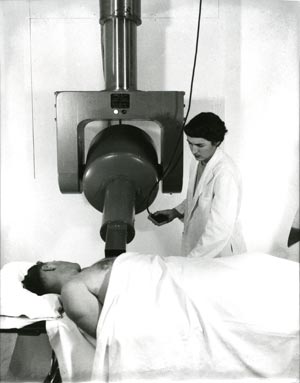Full History
On March 4, 2011, the Government of Saskatchewan announced initial funding for an institute for nuclear sciences of $30 million over seven years. Its purpose was to place Saskatchewan among national and global leaders in nuclear research, development and training. Originally called the Canadian Centre for Nuclear Innovation, and established under the Canada Not-for-Profit Corporations Act, the organization had a single corporate Member, the University of Saskatchewan, an independent Board of Directors, and a head office in Saskatoon. The name was changed to the Sylvia Fedoruk Canadian Centre for Nuclear Innovation in October, 2012, to commemorate the Honorable Dr. Sylvia Fedoruk.
At the same time, capital funding was secured through Innovation Saskatchewan and Western Economic Diversification Canada to establish a PET/CT facility at the Royal University Hospital, as well as a cyclotron and laboratories for handling nuclear substances, to be located close by at the University of Saskatchewan.
The prototype Call for Proposals was issued with a deadline for submission on August 10, 2012. An external expert Advisory Committee ranked 12 applications and 5 Projects were funded for a total of $366K, supporting research in nuclear medicine, fusion energy technology, public opinions on nuclear technology, radiation detectors for medical imaging, and nano-structures of electrified interfaces via neutron reflectometry. The Fedoruk Centre proceeded with periodic Calls for Proposals, committing $7.8M to 47 projects over the first decade of operation.
In 2013, the Fedoruk Centre accepted responsibility for operating the cyclotron and its labs, through an agreement with the University of Saskatchewan. Construction of the facility proceeded through to commissioning in 2015, at which time it was named the Saskatchewan Centre for Cyclotron Sciences (SCCS).
In 2015, the University of Saskatchewan, University of Regina, and the Fedoruk Centre established the Nuclear Imaging Program (NIP) through a tri-party agreement. The program built upon existing research and development capabilities in medical and life sciences. The program aimed to increase Saskatchewan’s capacity in nuclear imaging tools and techniques, with applications to life sciences in plants, animals and humans.
The Fedoruk Centre invested $5.2 million of funding over five years to the NIP, establishing three Research Chairs, a clinical research coordinator position, and equipment for the Cyclotron Facility to safely conduct of radiochemistry research and nuclear imaging of small animals. The universities made additional cash and in-kind contributions valued at $3.7M.
In June 2016, the Fedoruk Centre completed the cyclotron commissioning and began manufacturing the radiopharmaceutical fluorodeoxyglucose (FDG) for sale to regional hospitals for use in PET scanning. A quality program was established to comply with radiological and health regulators. Since then, FDG manufacturing has quickly ramped up to support PET/CT scanning at the Royal University Hospital (RUH). By 2020-2021, more than 2400 Saskatchewan patients each year had been scanned using locally-produced imaging agents to diagnose and treat cancer.
In May 2017, the Fedoruk Centre entered a partnership with the Johnson Shoyama Graduate School for Public Policy (JSGS) to establish a Program within the Centre for Science and Innovation Policy (CSIP). The purpose of the partnership was to strengthen Saskatchewan’s capacity to engage effectively and respectfully with the public on challenging questions of nuclear science and technology, as well as to promote evidence-informed decision-making on the application of nuclear technologies for social and economic benefit. An investment of $2M over 5 years attracted two new faculty members, and funded a cluster of Projects in: policy research on Major Research Facilities; the effects of deliberative engagement on public understanding; and prospects for small nuclear power generators in northern communities.
In 2018, the Fedoruk Centre accepted responsibility for operation of the Innovation Wing, at which time the Fedoruk Centre began to manage the entire facility, including the cyclotron, nuclear substance labs, GMP manufacturing area and laboratories for nuclear imaging, research and innovation in life sciences.
Besides simplifying compliance with the Canadian Nuclear Safety Commission (CNSC) and Health Canada licenses, this adjustment opened the door for funding from Innovation Saskatchewan, Western Economic Diversification and the Fedoruk Centre to jointly support a $4.2 million project to renovate and equip the Innovation Wing. The renovation added workstations suited for nuclear imaging, radiochemistry and housing of living specimens, accommodating the diverse needs of a growing community of facility users. The renovation project was completed in March of 2020.
The Fedoruk Centre continues to invest in programmatic partnerships with Saskatchewan institutions and to fund research projects led by Saskatchewan-based scientists in nuclear subject areas. Some of the research projects benefit from access to the workstations at the Cyclotron Facility.
The Honorable Dr. Sylvia Fedoruk (1927-2012)

In 1951, Dr. Fedoruk was a medical physicist and sole woman on a team at the University of Saskatchewan. That team was the first to ever successfully treat a cancer patient with cobalt-60 radiation therapy. Today, the device and techniques Dr. Fedoruk helped develop are used to treat cancer around the world. More than 45,000 treatments are delivered in over 80 countries every day.
Dr. Fedoruk was also the first female chancellor of the University of Saskatchewan, first female member of the Atomic Energy Control Board of Canada, and a member of both the Canadian Medical and Saskatchewan Sport Halls of Fame. She was an Officer of the Order of Canada, a Member of the Saskatchewan Order of Merit, and a Dame of the Order of St. John.
Stakeholders
The founding stakeholders of the Sylvia Fedoruk Canadian Centre for Nuclear Innovation were the Province of Saskatchewan and the University of Saskatchewan.
The initial funding was committed by the Government of Saskatchewan, through its agency Innovation Saskatchewan, in March 2011, and was intended to support operations over the first seven years. The Funding Agreement was renewed in April 2019, at which time the Fedoruk Centre began a transition towards a cost-shared sustainable business model.
The Fedoruk Centre continues to be governed as a not-for-profit corporation with an independent Board of Directors and a single Member, the University of Saskatchewan.
